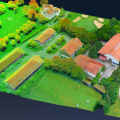In an effort to support humanitarian relief and human security activities around the world, DigitalGlobe has formed an alliance with the United Nations Institute for Training and Research’s Operational Satellite Applications Programme (UNOSAT) using FirstLook. UNOSAT aims to use satellite imagery for relief efforts, security, and strategic territorial and development planning within and outside of the United Nations system.
DigitalGlobe’s FirstLook crisis team supports UNOSAT efforts by continuously monitoring activities using sources such as the Global Disaster and Coordination System (GDACS) and the International Space Charter. Once the DigitalGlobe Analysis team identifies an event of interest, satellites are immediately tasked to collect imagery over the appropriate sites and provide online and downloadable access to UNOSAT experts.

The most consistent, efficient and reliable means to receive crisis-based and human security-oriented imagery
DigitalGlobe’s FirstLook is an online subscription service for emergency management that provides pre- and post-event imagery of world disasters. High-resolution satellite imagery provides the essential information required for emergency planning, risk assessment, damage assessment and recovery. Once an event has been identified, DigitalGlobe establishes high priority collection sites over the event. Post-event imagery of affected areas is acquired as soon as access allows, typically within 24 hours to 48 hours. The current imagery is available online within 12 hours after the imagery is collected.
(1).jpg)
Satellite imagery helps the UN succeed in emergency planning in Somali refugee camps
UNOSAT used FirstLook to proactively monitor several events, including those in Somalia. Due to extended drought, Somalia and other nations in Africa face severe food crisis. As a result, Somali residents have taken refuge in nearby Ethiopia and Kenya. UNOSAT has acquired DigitalGlobe satellite imagery to assess the situation across Somali border towns, and plan emergency humanitarian efforts based on the findings. UNOSAT began using satellite imagery for similar humanitarian uses in 2001; however, access to imagery was slow and uncertain, making relief difficult and unsafe.
A more informed response
After a trial with FirstLook, UNOSAT began using the program regularly in 2011. . "DigitalGlobe’s constellation can quickly collect large areas on Earth and has the flexibility to revisit critical areas on the same day,” UNOSAT Manager Francesco Pisano said. “Now that UNOSAT will access the imagery online via the FirstLook subscription service, we will have the most consistent, efficient and reliable means to receive crisis-based and human security-oriented imagery."
DigitalGlobe International Inc.
Peter Kinne
Regional Sales Director ANZ
Mobile: +61 4 47 534 726
For more information, visit www.digitalglobe.com.
Do come to our booth no. 56 at Spatial@Gov 2011 to find out more information about our products and solution.
![]()







